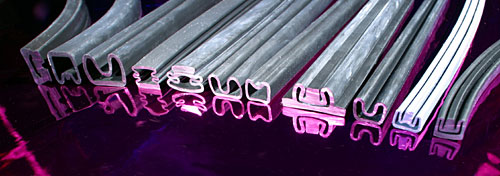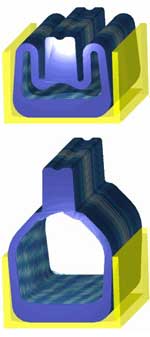Inflatable joints
Inflatable joints ensure a leak-tight seal between elements separated by a significant space. The unreeling of the joint under the effect of internal pressure allows the separation of two media. After inflation, the joint recovers its initial shape.
The applications are numerous. For example:
- Sealing of radioactive waste containers
- Sealing of sterile or dust-free rooms
- Sealing of fire break doors, train doors
- Sealing of oil tanker hatches (degassing zone)

Extruded inflatable joints (without fabric)
The inflated height is, at the most, two times the initial height. The internal pressure varies from 0.5 to 1 bar, while the wall thickness is around 2mm. The average initial height is from 15 to 30mm but it is possible to achieve heights up to 60mm. We produce joints with low development, from 2 to 3 mm, the function of which is identical. In this case, the internal pressure can rise to 2 bars.
Textile reinforced inflatable joints
These allow a large development and pressures of use from 2 to 4 bars. The textiles (polyester, etc.) may be incorporated in the material or on the surface. For certain applications, the use of several sheets may be necessary.
 Materials Materials
Different materials are recommended for extruded inflatable joints, depending on the environment.
- Ethylene propylene
- Acrylonitrile
-
Silicone
Fabric-backed inflatable joints are usually made out of silicone.
Inflating connections
These are manufactured to the client’s requirements, depending on the chosen position.
They are overmoulded on the inflatable joint or simply crimped with 1 or 2 box screws and made leak tight with self-vulcanising silicone.
The materials used are brass, stainless steel and steel.
Conclusions
The definition of an inflatable joint requires the following factors to be taken into account:
- Environment
- Height to be sealed
- Housing width
- Curve radius
- Pressure of use
- Lifetime (number of cycles)
The above indications are given as initial guidelines that need to be finalised with our technical services.
|

